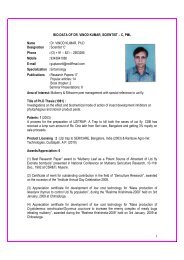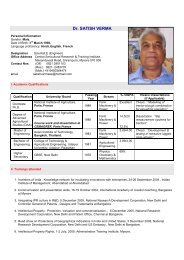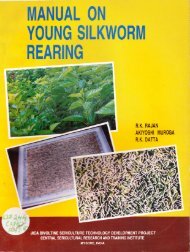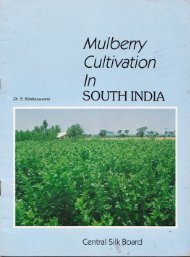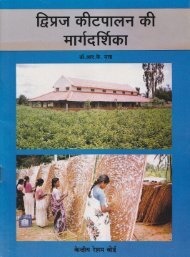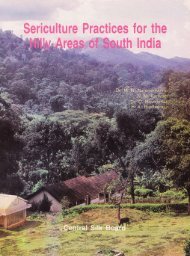BIVOLTINE RACE AND
Manual on Bivoltine Rearing, Race Maintenance and Multiplication
Manual on Bivoltine Rearing, Race Maintenance and Multiplication
- No tags were found...
Create successful ePaper yourself
Turn your PDF publications into a flip-book with our unique Google optimized e-Paper software.
4.1. Hygiienic conditions<br />
-<br />
-<br />
-<br />
-<br />
-<br />
Change the foot wear at the time of entering into the rearing room.<br />
Wash hands a.rd legs thoroughly before entering into the rearing house each time.<br />
Provide separate dress for workers at their work place.<br />
Do not ailow outsiders into the rearing house.<br />
Keep the rearing house and its surroundings clean and tidy throughout.<br />
- Disinfect the feet by stepiring on to the foot mat contairung l0% bleaching powder'in<br />
slaked lime.<br />
-<br />
-<br />
-<br />
-<br />
Rear silkworrns on a sheet paper in rearing tray.<br />
Collect silkworm bed refuse into litter basket/vinyl sheet meant for the-purpose.<br />
Dump the siikworm bed refuse in litter pit far from rearing house and mulberry gartlen<br />
and put bleaching powder around the pit.<br />
Use disinfected bed cleaning nets.<br />
Sprinkle a mixture of bleaching and slaked lime powder solution (1:9) in the surroundings<br />
of the rearing house periodically to prevent possible contamination.<br />
4.2. Chawki garden<br />
Young age silkworms require nutritious and succulent leaves. The rnoisture content of the<br />
leaves must be 78 - 80%. Hence, more attention should be given for increased nutrition (sugar<br />
and protein) and water content by altering the recommended dose of NPK through increasing F<br />
and K and also by adding more organic matter to the soil. Organic naatter may be in the form of<br />
FYM, compost or green manure which irnproves the water retention capacity of the soil.<br />
To exploit _,oung age rearing as a comrnercial venture, maintain an exclusive chawki<br />
garden and follow specific pruning and harvest methods to produce maximum good quality leaves<br />
for chawki rearing alone. The irnportant methods are:<br />
-<br />
-<br />
-<br />
Prepare land in flat areas with porous fertile soil" Select sandy loam soil.<br />
Select 536 variety for the new garden. However, existing K2 gardenwith 60cm x 60cm<br />
spacing can be converted as chawki plot.<br />
If there is no separate chawki plot,l/ethof the garden canbe specified as chawki garden<br />
where irrigation should be repeated every 4th-5th day or sprinklers may be used every<br />
day for keeping the soil moisture status near field capacity. The mulberry earmarked<br />
for chawki should be pruned around 5 days later ttan- the h-Otmal scheclule.<br />
4.3. Schedule of operation<br />
After the establishment period of one year, the plants should be pruned at crown height<br />
of 20 cm above the ground level with the onset of monsoon. After 35 days of pruning, harvesting<br />
of leaves can be commenced for next 1.0 days (upto 2nd moult). At the end of rearing, the top<br />
terminal bud is to be clipped. After 25 days of top clipping the second leaf harvesting as shootlets<br />
(secondary shootlets) is to be done for rearing of worms upto second moult. There after, plants<br />
are again pruned at crown (SOth day after first pruning).:fhis cycle has to be repeated 4 times<br />
to get eight crops in a year (Fig. 5).




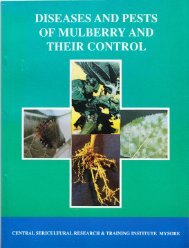

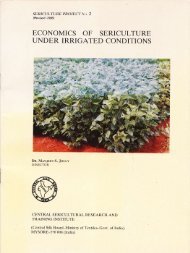
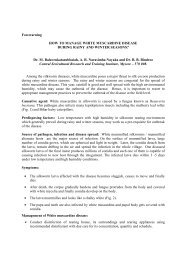
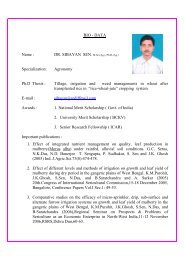
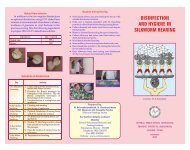
![E}A]\GALORE](https://img.yumpu.com/54052619/1/190x260/eagalore.jpg?quality=85)

